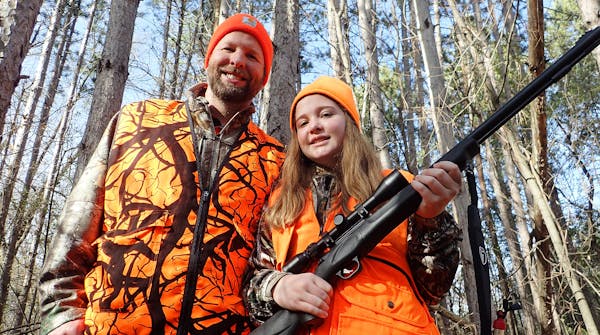 See
more of the story
See
more of the story
In this year of surprises, hunting deer in November in short sleeves perhaps should have been expected. That was the case Saturday, when the state's firearms season opened and hundreds of thousands of gun-toting Minnesotans climbed into tree stands hot, perhaps, but not bothered.
As part of that throng, some friends and I had set up a sort of urban hunting camp, gathering around a campfire on the metro's northern outer ring on the eve of the opener. The tradition of meeting Up North to sleep head to toe in bunks along the walls of ramshackle lean-tos seemed somehow not so inviting in this pandemic-infused year.
So John Weyrauch, one of our bunch, thawed a package of tenderloins from a whitetail buck he had dropped a year ago, sculpted them into medallions, and after seasoning and marinating them for a day, seared them over the open wood fire that entertained us Friday evening. As a bonus, the sky was clear, the breeze gentle and we were only two full moons away from 2021.
It's an acknowledged fact that the greater metro has been for some time overrun with deer, with does being far more abundant than bucks. Obvious as the solution is to kill more does than bucks, that doesn't happen often enough to relieve the congestion.
A broader but related argument about the proper age and sex ratios of Minnesota's whitetail herd pits some hunters against Department of Natural Resources big-game managers, who for generations have constructed deer seasons that almost literally place a bounty on anything with antlers. Yearlings, therefore, make up the largest percentage of bucks killed in Minnesota, year after year.
Rather than encourage this open season on young bucks, these animals should be better protected, the hunters say, while the killing of does should be required more often, with a goal of reducing the size of the overall herd while aligning its sex and age ratios more along their natural orders.
Instead we have what we have: Whitetail herds overpopulated with does and underpopulated with mature bucks.
For this reason among others, Terry Arnesen, who owns the land we hunted Saturday, encourages doe harvests when possible, siding, in effect, with the old adage, "You can't eat horns!" which argues that the noblest wall-hanger is no tastier than the daintiest doe.
"All that being said, I haven't seen as many deer around this year as I have in past years,'' Terry said. "I don't know what it is, but they just don't seem to be around as much.''
Those words were still ping-ponging in my head as I settled into my stand a short while before 6:30 Saturday morning. John by then was already in his perch, as was the rest of our small gang, numbering five in all.
Which is when nothing happened for a prolonged period.
A dog did bark in the distance. A squirrel shimmied the length of a fallen tree. And a small flock of buffleheads settled into a nearby pond, followed by a pair of mallards that slipped air through their primary feathers, honeycombing gracefully downward.
All of which was entertaining. And as weird as the warm weather was — and as responsible, perhaps, for the non-movement of whitetails we were experiencing — it bore a certain appeal as the sun rose higher in the sky.
OK, there are no deer, I thought. But I don't have gloves on, either. Or a parka. And my feet aren't cold.
Which is when by happenstance I glanced a doe perhaps 50 yards behind me, walking away. I had no chance with my slug shooter, yet my pulse quickened as I watched the animal disappear deeper into the woods. This was followed a half-hour later by the appearance of a small buck, a basket 6-pointer, that I could have killed but instead watched as he followed the doe's trail.
Enough time passed to suggest the morning's excitement had come and gone, when a doe rocketed toward me from the deep woods.
When the animal reached the woods' edge, which abutted a field, I grunted, and just like on TV, she hit the brakes, perhaps 35 yards away.
My gun's report shattered the otherwise quiet morning.
Soon enough, John got his tractor running and we moved the doe to a distant pasture, where I field-dressed her.
So it went on a warm opening day. Not Up North, but in the north metro.





